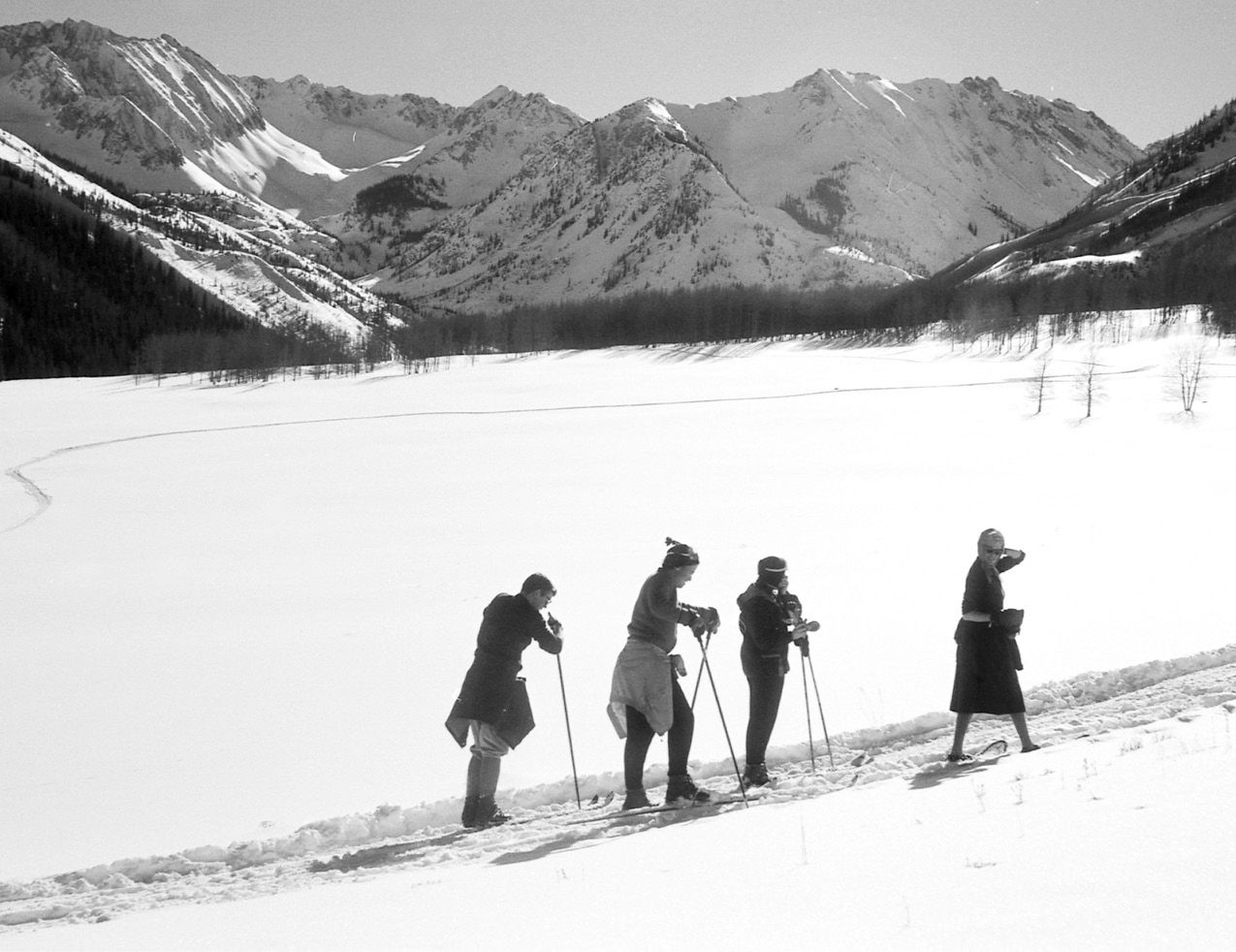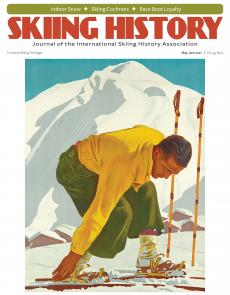SKIING HISTORY
Editor Greg Ditrinco
Consulting Editor Seth Masia
Art Director Edna Baker
Editorial Board
Seth Masia, Chairman
John Allen, Andy Bigford, John Caldwell, Jeremy Davis, Kirby Gilbert, Paul Hooge, Jeff Leich, Bob Soden, Ingrid Wicken
Founding Editors
Morten Lund, Glenn Parkinson
To preserve skiing history and to increase awareness of the sport’s heritage
ISHA Founder
Mason Beekley, 1927–2001
ISHA Board of Directors
Rick Moulton, Chairman
Seth Masia, President
Wini Jones, Vice President
Jeff Blumenfeld, Vice President
John McMurtry, Vice President
Bob Soden (Canad), Treasurer
Einar Sunde, Secretary
Richard Allen, Skip Beitzel, Michael Calderone, Art Currier, Dick Cutler, David Ingemie, Joe Jay Jalbert, Henri Rivers, Charles Sanders, Christof Thöny (Austria), Ivan Wagner (Switzerland)
Presidential Circle
Christin Cooper, Billy Kidd, Jean-Claude Killy, Bode Miller, Doug Pfeiffer, Penny Pitou, Nancy Greene Raine
Membership Services
Laurie Glover
(802) 375-1105
laurie@skiinghistory.org
Corporate Sponsorships
Peter Kirkpatrick
(541) 944-3095
peterk10950@gmail.com
Bimonthly journal and official publication of the International Skiing History Association (ISHA)
Partners: U.S. Ski and Snowboard Hall of Fame | Canadian Ski Museum and Hall of Fame
Alf Engen Ski Museum | North American Snowsports Journalists Association | Swiss Academic Ski Club
Skiing History (USPS No. 16-201, ISSN: 23293659) is published bimonthly by the International Skiing History Association, P.O. Box 1064, Manchester Center, VT 05255.
Periodicals postage paid at Manchester Center, VT and at additional mailing offices. Postmaster: Send address changes to ISHA, P.O. Box 1064, Manchester Center, VT 05255
ISHA is a 501(c)(3) public charity. EIN: 06-1347398
Written permission from the editor is required to reproduce, in any manner, the contents of Skiing History, either in full or in part.
Faster, Easier, Better: Evolution of XC Track Setting
Top: Early trail prep was achieved by snowshoeing first, then skiers next. Elizabeth Paepcke follows that format in 1956 in Colorado’s Ashcroft Valley. (Aspen Historical Society, Durrance Collection)
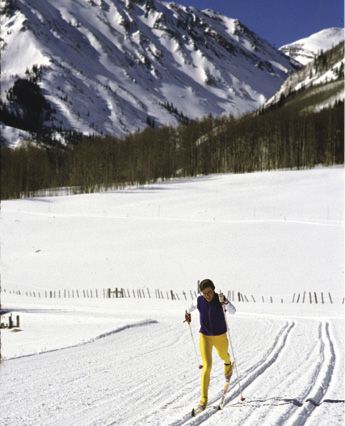
skier enjoys the benefits of modern
track setting. Aspen Historical Society,
Russell Collection
For any sport, the condition of the playing surface is vital to success. For that reason, ski-touring centers strive to provide guests with well-designed trails groomed to perfection. Over the last half-century, setting and maintaining cross-country tracks has progressed from an arduous process requiring many workers to an efficient, machine-reliant method that uses just one person to operate the levers, buttons and switches.
Before the 1960s, trail preparation required significant effort. Trails could be created simply by snowshoeing, then skiing over the route. But prepping for major events or competitions required trail crews to shovel, rake, pack—and then set parallel ski tracks. It took a lot of time and effort. Consider the early staging of the annual 50-km Holmenkollen race in Oslo, which first started in 1888. Two 25-km laps translated into roughly 15 miles of snow that needed to be shoveled, packed and prepped.
Leading up to the 1960 Winter Olympics in Squaw Valley, two young American Nordic coaches, Al Merrill and Chummy Broomhall, started experimenting with a new grooming method. Both New Englanders with farming backgrounds and a Yankee knack for problem solving, they were familiar with the fine-toothed rotary tillers used to grade soil, leaving it soft and workable. Attaching a rototiller behind a Tucker snowcat, they realized, did the same for snow. Just one person operating a tiller could roll out
kilometer after kilometer of smooth, snow-carpeted trails.
Although the gyro-groomer, as it came to be known, was a major advance, other work was still required; skiers had to follow the groomer to stamp in a ski track. At Squaw Valley that job was done by the race forerunners and post-runners—skiers who had just missed the Olympic team cut.
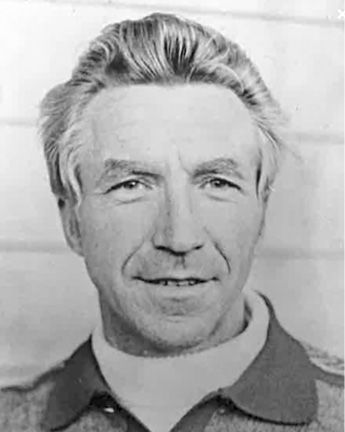
coach, engineered a crude but
effective tracksetter: a wooden
box with runners on the bottom.
But help was not far off. Enter Sven Johansson, who raced for the United States at the Squaw Valley Games, then took the job of US biathlon head coach. Starting in 1961, the team was stationed in Fort Richardson, Alaska, which regularly received snowfall that filled in the ski tracks. Partly out of desperation, Johansson devised a remarkably easy and effective solution to track setting: a 28-inch by 36-inch wooden box with two runners on the bottom that simulated skis. When pulled behind a snowcat, with a cinder block or two added for weight, the sled created parallel ski tracks for the afternoon’s training session—likely one of the first mechanical track setters.
Thanks to this breakthrough, the days of strenuous and time-consuming snow shoveling, snowshoe packing and stamping in ski tracks were on their way out.
Johansson sent me a hand-drawn copy of the track-sled building plans. (We had become good friends during a three-week Olympic training camp in Idaho, where I was a coach.) At the time, I was working with the Lyndon Outing Club in Vermont, and we built a prototype sled to set tracks for a race in December 1963. Afterward, a group of high school and college coaches swarmed around the sled, asking for plans, which I later mailed out.
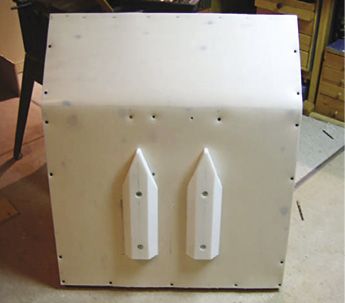
from Johansson's device.
A similar scenario was unfolding in southern Vermont. John Caldwell, a former Olympic skier and a coach at the Putney School, had recruited a skilled carpenter to help him invent a comparable track-setting sled. Just as in Lyndonville, at the end of each race, coaches gathered around the new contraption, asking questions and taking measurements. Mechanical track-setters began cropping up at other schools and colleges, and at Eastern-sanctioned races.
Around this time, Ski-Doo snowmobiles became popular, and these machines turned out to be perfect for pulling a track setter. A typical Nordic setup in the mid-1960s consisted of a Ski-Doo pulling a homemade box sled with a clothesline. It got the job done, but it was still a far cry from what we use today.
Soon, modifications improved the design of track-setting equipment. Wooden sleds
were outfitted with metal blades to cut ski tracks in frozen show, and then polycarbonate bottoms were added to the sleds to reduce friction. Side runners could raise the frame in places where tracks were not wanted or for road crossings. Metal sleds replaced the wooden ones.
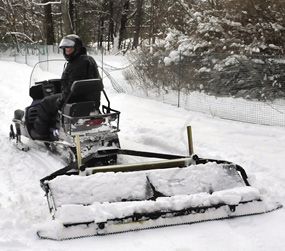
remains a low-cost constant.
As commercial versions of the devices became available, the whole cross-country scene took on a new look and feel. Ski-touring areas could now offer wide, smooth trails with perfectly straight, machine-set tracks, and their guests loved these beautifully prepared surfaces.
In Scandinavia and the rest of Europe, the evolution of trail preparation seems to have progressed much more slowly. According to Caldwell, the Norwegians were still shoveling snow to prepare the tracks at the 1966 FIS Nordic World Championships in Oslo. He recalls skiing behind a large snow machine at the 1968 Olympics in France—eight years after the more efficient methods of trail preparation had been used at the Squaw Valley Winter Games. But eventually, the Europeans caught up. In 1971, for example, Harry Brown imported an all-metal heavy frame sled from Sweden that produced good tracks in hard-packed and frozen snow.
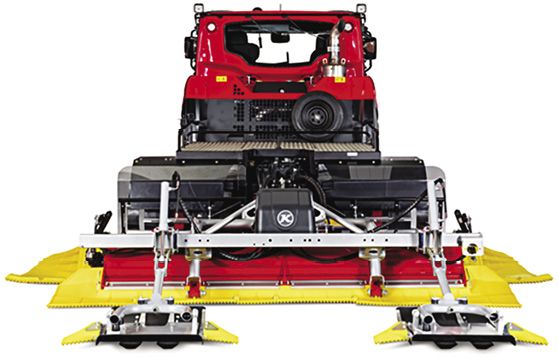
multiple tracks in a single pass.
Photo: Pisten Bully
Want to see what enables a modern ski-touring center to weave its trail magic? Next time you are at Craftsbury Outdoor Center, the Trapp Family Lodge or any other major cross-country operation, take a look through the window of the maintenance shop. You will probably see a wide-track Pisten Bully with a hydraulically controlled snowplow up front and a multi-purpose groomer/grader/track setter behind. This rig can lay down kilometer after kilometer of corduroy, with twin tracks for classic skiers.
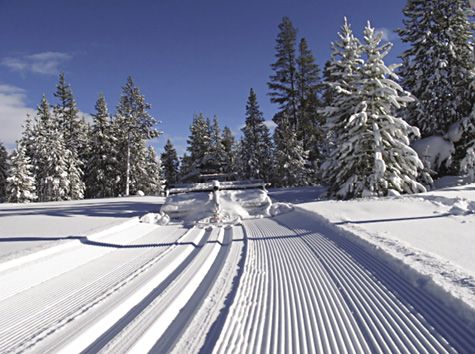
and skate-ski option on the
same trail.
Picture the modern-day trail worker who drives the machine. Replacing dozens of workers on snowshoes, he or she simply hops into the cab, turns on the heater, and switches on the stereo. A press on the ignition switch, and the 250-horsepower engine roars to life. Hit the horn twice, slip into first gear, and roll out into the winter to begin an hour or two of grooming. 
Rick Eliot is a former collegiate racer and coach who lives in Massachusetts. Thanks to John Caldwell for his help with this article.



courtesy Pisten Bully

courtesy Pisten bully
A typical track-setting rig in the mid-1960s consisted of a Ski-Doo pulling a homemade box with a clothesline.
Modern groomers are high-tech, multi-use masters that can pack, smooth and create tracks in one pass. Groomers can now customize trail prep, for instances by varying the number of tracks and the width between tracks.


Top: Improved grooming provides classic tracks and skate-ski options on the same trail. Left: A snowmobile pulling a roller remains a low-cost constant at many cross-country centers.
Table of Contents

Corporate Sponsors
ISHA deeply appreciates your generous support!
WORLD CHAMPIONSHIP ($3,000 AND UP)
Gorsuch
Polartec
CHAMPIONSHIP ($2,000)
Fairbank Group: Bromley, Cranmore, Jiminy Peak
Hickory & Tweed Ski Shop
WORLD CUP ($1,000)
Aspen Skiing Company
Bogner
Boyne Resorts
Dale of Norway
Darn Tough Vermont
Dynastar | Lange | Look
Gordini USA Inc. | Kombi LTD
HEAD Wintersports
Intuition Sports, Inc.
Mammoth Mountain
Marker-Volkl USA
National Ski Areas Association
Outdoor Retailer
Rossignol
Ski Area Management
Ski Country Sports
Snowsports Merchandising Corporation
Sport Obermeyer
Sports Specialists, Ltd.
Sun Valley Resort
Vintage Ski World
Warren and Laurie Miller
Yellowstone Club
GOLD ($700)
Larson's Ski & Sport
Race Place | BEAST Tuning Tools
The Ski Company (Rochester, NY)
Thule
SILVER ($500)
Alta Ski Area
Boden Architecture PLLC
Dalbello Sports
Deer Valley
Ecosign Mountain Resort Planners
Fera International
Holiday Valley
Hotronic USA, Inc. | Wintersteiger
MasterFit Enterprises
McWhorter Driscoll, LLC
Metropolitan New York Ski Council
Mt. Bachelor
New Jersey Ski & Snowboard Council
Russell Mace Vacation Homes
Schoeller Textile USA
Scott Sports
Seirus Innovations
SeniorsSkiing.com
Ski Utah
Steamboar Ski & Resort Corporation
Swiss Academic Ski Club
Tecnica Group USA
Timberline
Trapp Family Lodge
Western Winter Sports Reps Association
World Pro Ski Tour

